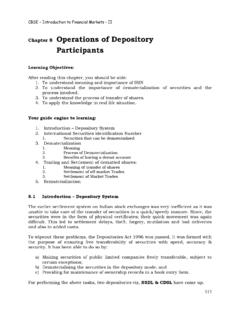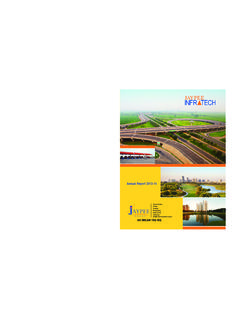Transcription of A Study On Customer Satisfaction Of Commercial …
1 IOSR Journal of Business and Management (IOSR-JBM) e-ISSN: 2278-487X, p-ISSN: 2319-7668. Volume 15, Issue 1 (Nov. - Dec. 2013), PP 60-86 60 | Page A Study On Customer Satisfaction Of Commercial Banks:Case Study On State bank Of India Amruth Raj Nippatlapalli Business Management, ,Vikrama Simhapuri University,India Abstract: Customer Satisfaction , a term frequently used in marketing, is a measure of how products and services supplied by a company meet or surpass Customer expectation. Customer Satisfaction is defined as "the number of customers, or percentage of total customers, whose reported experience with a firm, its products, or its services (ratings) exceeds specified Satisfaction goals.
2 "Banking in India originated in the last decades of the 18th century. The first banks were The General bank of India, NOW which started in 1786, and bank of Hindustan , which started in 1790; both are now defunct. The oldest bank in existence in India is the State bank of India , which originated in the bank of Calcutta in June 1806, which almost immediately became the bank of Bengal. This was one of the three presidency banks, the other two being the bank of Bombay and the bank of Madras , all three of which were established under charters from the British East India Company. For many years the Presidency banks acted as quasi-central banks, as did their successors.
3 The three banks merged in 1921 to form the Imperial bank of India. Keywords: Bankinghistory in INDIA, Conclusion,Customers Satisfaction , List of Commercial Banks, Research Methodology, I. Introduction " Customer Satisfaction is measured at the individual level, but it is almost always reported at an aggregate level. It can be, and often is, measured along various dimensions. A hotel, for example, might ask customers to rate their experience with its front desk and check-in service, with the room, with the amenities in the room, with the restaurants, and so on. Customer Satisfaction , a term frequently used in marketing, is a measure of how products and services supplied by a company meet or surpass Customer expectation.
4 Customer Satisfaction is defined as "the number of customers, or percentage of total customers, whose reported experience with a firm, its products, or its services (ratings) exceeds specified Satisfaction goals." In a survey of nearly 200 senior marketing managers, 71 percent responded that they found a Customer Satisfaction metric very useful in managing and monitoring their businesses. " Customer Satisfaction provides a leading indicator of consumer purchase intentions and loyalty. " Customer Satisfaction data are among the most frequently collected indicators of market perceptions. Customer service is the provision of service to customers before, during and after a purchase.
5 According to Turban et al. (2002), " Customer service is a series of activities designed to enhance the level of Customer Satisfaction that is, the feeling that a product or service has met the Customer expectation." Customer Satisfaction is an ambiguous and abstract concept and the actual manifestation of the state of Satisfaction will vary from person to person and product/service to product/service. The state of Satisfaction depends on a number of both psychological and physical variables which correlate with Satisfaction behaviors such as return and recommend rate. The level of Satisfaction can also vary depending on other options the Customer may have and other products against which the Customer can compare the organization's services Industry Profile: Banking in India: Banking in India originated in the last decades of the 18th century.
6 The first banks were The General bank of India, NOW which started in 1786, and bank of Hindustan , which started in 1790; both are now defunct. The oldest bank in existence in India is the State bank of India , which originated in the bank of Calcutta in June 1806, which almost immediately became the bank of Bengal. This was one of the three presidency banks, the other two being the bank of Bombay and the bank of Madras , all three of which were established under charters from the British East India Company. For many years the Presidency banks acted as quasi-central banks, as did their successors. The three banks merged in 1921 to form the Imperial bank of India , which, upon India's independence, became the State bank of India in 1955.
7 A Study On Customer Satisfaction Of Commercial Banks:Case Study On State bank Of India 61 | Page History: Indian merchants in Calcutta established the Union bank in 1839, but it failed in 1848 as a consequence of the economic crisis of 1848-49. The Allahabad bank , established in 1865 and still functioning today, is the oldest Joint Stock bank in India.(Joint Stock bank : A company that issues stock and requires shareholders to be held liable for the company's debt) It was not the first though. That honor belongs to the bank of Upper India, which was established in 1863, and which survived until 1913, when it failed, with some of its assets and liabilities being transferred to the Alliance bank of Simla.
8 When the American Civil War stopped the supply of cotton to Lancashire from the Confederate States, promoters opened banks to finance trading in Indian cotton. With large exposure to speculative ventures, most of the banks opened in India during that period fey and lost interest in keeping deposits with banks. Subsequently, banking in India remained the exclusive domain of Europeans for next several decades until the beginning of the 20th century. Foreign banks too started to arrive, particularly in Calcutta, in the 1860s. The Comptoire d'Escompte de Paris opened a branch in Calcutta in 1860, and another in Bombay in 1862; branches in Madras and Pondicherry, then a French colony, followed.
9 HSBC established itself in Bengal in 1869. Calcutta was the most active trading port in India, mainly due to the trade of the British Empire, and so became a banking center. The first entirely Indian joint stock bank was the Oudh Commercial bank , established in 1881 in Faizabad. It failed in 1958. The next was the Punjab National bank , established in Lahore in 1895, which has survived to the present and is now one of the largest banks in India. Around the turn of the 20th Century, the Indian economy was passing through a relative period of stability. Around five decades had elapsed since the Indian Mutiny, and the social, industrial and other infrastructure had improved.
10 Indians had established small banks, most of which served particular ethnic and religious communities. The presidency banks dominated banking in India but there were also some exchange banks and a number of Indian joint stock banks. All these banks operated in different segments of the economy. The exchange banks, mostly owned by Europeans, concentrated on financing foreign trade. Indian joint stock banks were generally under capitalized and lacked the experience and maturity to compete with the presidency and exchange banks. This segmentation let Lord Curzon to observe, "In respect of banking it seems we are behind the times.

















